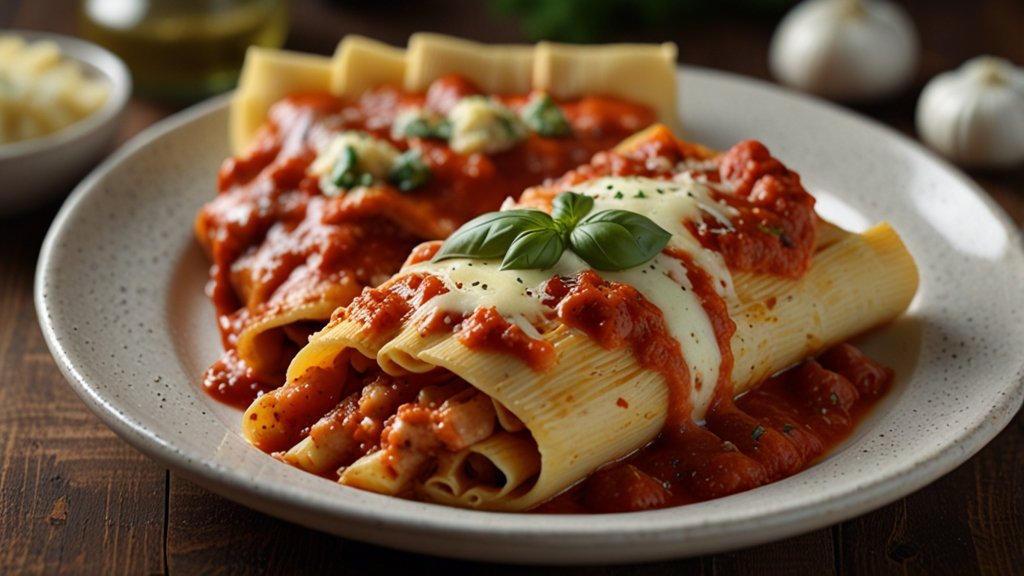Picture this: It’s a chilly Sunday evening. The aroma of simmering tomato sauce and melted cheese wraps around your kitchen like a warm hug. You pull a bubbling baking dish from the oven – golden, cheesy, impossibly inviting. At its heart? Those beloved, generously stuffed pasta tubes known as Mannacote or Manicotti. If you’ve stumbled upon the term “Mannacote” and felt a flicker of curiosity (or perhaps confusion!), you’re not alone. Let’s unravel this delicious mystery together. Essentially, Mannacote is simply another name for the classic Italian-American wonder: Manicotti. Think of it as a regional variation or a charming linguistic cousin – same incredible dish, just a slightly different spelling on the menu. Get ready to master the art of creating this comforting, crowd-pleasing baked pasta masterpiece.
What Exactly is Mannacote? Decoding the Deliciousness
Mannacote (pronounced man-uh-KOH-tee or man-uh-KOT), more widely recognized as Manicotti, is a cornerstone of Italian-American cuisine. At its core, it features large, cylindrical pasta tubes (canelloni tubes are often used interchangeably). These tubes become edible vessels, lovingly stuffed with a creamy, rich filling – most traditionally a blend of ricotta cheese, mozzarella, Parmesan, egg, and herbs. The stuffed pasta is then nestled in a flavorful sauce (usually a robust tomato sauce or sometimes a béchamel), topped with more cheese, and baked until golden, bubbly, and irresistibly fragrant. The name Mannacote itself likely stems from regional dialects or historical misspellings of “Manicotti” (meaning “little sleeves” or “muffs” in Italian) that gained local traction. Regardless of the name on the box or the recipe, the result is pure, cheesy comfort.
Gathering Your Mannacote Arsenal: Essential Ingredients
Before we dive into the fun part, let’s assemble your flavor toolkit. Using high-quality ingredients makes a noticeable difference in your finished Mannacote.
The Foundation:
- Mannacote/Manicotti Pasta Tubes: 1 box (typically 8 oz, containing 12-14 tubes). Look for large, ridged tubes specifically labeled Manicotti or Cannelloni.
- Marinara Sauce: 4-5 cups (about 32-40 oz). Homemade is fantastic, but a good quality jarred sauce works perfectly.
The Irresistible Filling:
- Whole Milk Ricotta Cheese: 32 oz (4 cups). Drain off any excess liquid for a firmer filling.
- Shredded Mozzarella Cheese: 2 cups (divided – 1.5 cups for filling, 0.5 cup for topping). Low-moisture, part-skim works best.
- Grated Parmesan Cheese: 1 cup (divided – 3/4 cup for filling, 1/4 cup for topping). Freshly grated offers superior flavor.
- Large Egg: 1. Acts as the binder.
- Fresh Parsley: 1/4 cup, finely chopped.
- Fresh Basil: 2 tbsp, finely chopped (or 1 tsp dried).
- Dried Oregano: 1 tsp.
- Garlic Powder: 1 tsp (or 2 cloves fresh garlic, minced).
- Salt: 1 tsp (or to taste).
- Black Pepper: 1/2 tsp (or to taste).
Optional Flavor Boosters:
- Cooked Ground Meat: 1/2 lb (Italian sausage, beef, or a mix – browned and drained).
- Cooked Spinach: 1 (10 oz) package frozen spinach, thawed and thoroughly squeezed dry.
- Nutmeg: A tiny pinch (about 1/8 tsp) in the filling.
Table 1: Mannacote Ingredient Cheat Sheet
| Component | Essential Ingredients | Common Variations |
|---|---|---|
| Pasta | Manicotti/Cannelloni Tubes (8 oz box) | Jumbo Shells (Conchiglioni) |
| Sauce Base | Marinara (4-5 cups) | Arrabbiata, Meat Sauce, Alfredo, Béchamel |
| Cheese Filling | Ricotta (32oz), Mozzarella (1.5c), Parmesan (3/4c) | Cottage Cheese, Romano, Asiago |
| Binders & Flavor | Egg (1), Parsley, Basil, Oregano, Garlic, S&P | Nutmeg, Red Pepper Flakes, Lemon Zest |
| Add-Ins | — | Ground Meat, Spinach, Mushrooms, Peas |
Crafting Perfect Mannacote: Your Step-by-Step Culinary Journey
Follow these steps for foolproof, restaurant-worthy Mannacote right from your oven.
1. Prepping the Pasta Tubes: The Crucial First Step
- Bring a large pot of generously salted water to a rolling boil.
- Carefully add the Mannacote tubes. Stir gently to prevent sticking.
- Cook for only 6-7 minutes, or until al dente (slightly firm to the bite). They will soften further during baking. Overcooking now leads to tearing later!
- Immediately drain the tubes and rinse them under cold water to stop the cooking process. This makes handling much easier.
- Gently lay the tubes in a single layer on clean kitchen towels or parchment paper to dry. Pat the outside lightly.
2. Creating the Dreamy Filling
- In a large bowl, combine the drained ricotta, 1.5 cups mozzarella, 3/4 cup Parmesan, egg, parsley, basil, oregano, garlic powder, salt, and pepper.
- If using optional add-ins (meat, spinach), fold them in gently but thoroughly at this stage. Ensure spinach is incredibly dry to avoid a watery filling.
- Mix everything together until just combined. Avoid overmixing, which can make the filling gummy. Taste and adjust seasoning if needed.
3. The Art of Stuffing: Patience is Key
- Preheat your oven to 375°F (190°C).
- Spread about 1 cup of your marinara sauce evenly over the bottom of a 9×13 inch baking dish. This prevents sticking and adds flavor from below.
- Stuffing Method 1 (Piping Bag): Transfer the filling to a large piping bag (or a sturdy plastic bag with a corner snipped off). Gently insert the tip into one end of a pasta tube and squeeze, filling it until the cheese mixture just reaches the other end. Place seam-side down in the baking dish.
- Stuffing Method 2 (Spoon & Fingers): Carefully hold a tube in one hand. Use a small spoon (like a teaspoon or espresso spoon) or your clean fingers to gently push the filling into both ends of the tube until full. Place seam-side down in the dish. This method is therapeutic!
- Repeat until all tubes are stuffed and nestled snugly in the dish. It’s okay if they touch.
4. Saucing, Cheesing, and Baking to Perfection
- Pour the remaining marinara sauce evenly over the top of the stuffed tubes, ensuring they are mostly covered.
- Sprinkle the reserved 1/2 cup mozzarella and 1/4 cup Parmesan cheese evenly over the sauce.
- Optional: For extra golden goodness, drizzle lightly with olive oil or dot with small pieces of butter.
- Cover the baking dish tightly with aluminum foil. This traps steam, ensuring the pasta finishes cooking and the filling heats through without drying out.
- Bake covered for 25 minutes.
- Carefully remove the foil and bake uncovered for an additional 15-20 minutes, or until the sauce is bubbling vigorously around the edges and the cheese on top is melted, golden, and slightly spotty-brown.
- CRUCIAL STEP: Remove the dish from the oven and let it rest for at least 10-15 minutes before serving. This allows the filling to set slightly, making the Mannacote much easier to serve without everything oozing out.
Pro Tips from Nonna’s Kitchen (Without the Pinched Cheeks)
- Avoid the Tear: Undercook the pasta slightly! A firm al dente tube is far easier to stuff than a soft, floppy one.
- Dry Ricotta is Happy Ricotta: Place ricotta in a fine-mesh strainer over a bowl for 30 minutes before using. Discard the liquid. Your filling will be gloriously thick.
- Sauce Consistency: Ensure your sauce isn’t too thin. Simmer it uncovered for 10-15 minutes before assembling if needed. A thicker sauce prevents a watery baked dish.
- Room Temp Filling: Let your cheese mixture sit at room temperature for 20-30 minutes before stuffing. It pipes or spoons much easier.
- Freeze for Future Feasts: Assemble the Mannacote completely (stuffed, sauced, cheesed) but do not bake. Cover tightly with foil and freeze. Bake from frozen (add 15-20 mins covered time) for an incredible freezer meal. You can also freeze leftovers beautifully.
Beyond the Basics: Delicious Mannacote Variations
The classic ricotta filling is divine, but Mannacote is a canvas for creativity!
- Meat Lover’s Delight: Add 1/2 lb of browned, seasoned ground beef, Italian sausage, or a mix to the cheese filling. Or, swap the marinara for a hearty meat ragù.
- Garden Fresh Vegetarian: Fold in 1 cup of finely chopped, sautéed mushrooms, bell peppers, and zucchini (well-drained!) along with the spinach. A roasted red pepper sauce adds vibrant flavor.
- Four-Cheese Fiesta: Swap half the ricotta for creamy cottage cheese (small curd, drained) or mascarpone. Add shredded provolone or fontina to the mix.
- Seafood Sensation: Fold in 1 cup of cooked, chopped shrimp, crab, or scallops into the cheese filling. Pair with a lighter tomato-seafood sauce or a lemon-herb bechamel.
- Gluten-Free & Low-Carb: Use large gluten-free pasta tubes or swap the pasta entirely! Stuff the cheese mixture into thinly sliced zucchini or eggplant “rollatini” style. Bake as directed.
Serving Your Masterpiece: The Grand Finale
- Rest is Best: Seriously, let it sit! Those 10-15 minutes post-bake are non-negotiable for clean slices.
- Garnish Gracefully: A sprinkle of fresh chopped basil or parsley adds color and a burst of freshness right before serving.
- Perfect Pairings: Serve your Mannacote with:
- A crisp, green salad with a tangy Italian vinaigrette.
- Warm, crusty garlic bread or focaccia for mopping up sauce.
- A medium-bodied Italian red wine like Chianti or Sangiovese, or a dry Pinot Grigio.
- Leftover Love: Reheat individual portions gently in the microwave or covered in a 350°F oven until warmed through. Tastes even better the next day!
Conclusion: Embrace the Joy of Mannacote
Making Mannacote isn’t just about dinner; it’s about embracing a tradition of comfort, sharing, and homemade love. While the name “Mannacote” might be less common, the soul of the dish – those tender pasta tubes cradling a luscious cheese filling, bathed in vibrant sauce and crowned with molten cheese – is universally adored. Don’t be intimidated by the stuffing step; embrace it as part of the charm. Whether you stick faithfully to the classic ricotta blend or venture into exciting variations, the result is guaranteed satisfaction. So, gather your ingredients, preheat your oven, and experience the magic of creating this iconic Italian-American bake. Your kitchen (and your taste buds) will thank you. Buon Appetito!
Frequently Asked Questions
- Is Mannacote the same as Manicotti?
Absolutely! Mannacote is essentially a variation or alternative spelling for Manicotti. They refer to the same delicious baked pasta dish featuring large stuffed tubes. - Can I use no-boil lasagna noodles instead of Manicotti tubes?
Yes! This is a popular hack. Cook the lasagna noodles very al dente (about 5 mins), rinse in cold water, and lay flat. Spread filling along each noodle, roll it up, and place seam-side down in the sauced dish. Adjust baking time slightly (maybe 5 mins less covered). - Why did my Manicotti filling turn out watery?
The main culprits are: 1) Ricotta not drained enough, 2) Frozen spinach not squeezed thoroughly dry, 3) Overcooked pasta absorbing too much sauce, or 4) Sauce being too thin. Ensure proper draining and sauce thickness. - Can I make Mannacote ahead of time?
Definitely! Assemble the entire dish (stuffed, sauced, cheesed), cover tightly, and refrigerate for up to 24 hours before baking. Add 5-10 minutes to the covered baking time if starting cold. You can also freeze the unbaked dish for up to 3 months (thaw overnight in fridge before baking, or bake from frozen adding extra covered time). - What’s the best way to reheat leftover Mannacote?
For best results, reheat individual portions in a 350°F (175°C) oven, covered with foil, until heated through (about 20-25 mins). You can also microwave on medium power in 1-2 minute intervals, but the oven preserves texture better. - Can I use cottage cheese instead of ricotta?
Yes! Small-curd, whole-milk cottage cheese is a common and delicious substitute. Drain it well and consider blending it briefly for a smoother texture if desired. The flavor is slightly tangier. - My manicotti tubes keep tearing when I stuff them. Help!
This usually means they were overcooked initially. Cook them only until very al dente (6-7 mins max). Rinsing in cold water immediately stops cooking and firms them up. Ensure they are completely cool and dry before stuffing. Using a piping bag can also be gentler than spooning.
YOU MAY ALSO LIKE: Çeciir – A Timeless Turkish Stew to Delight Your Taste Buds











